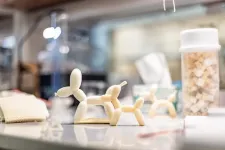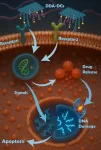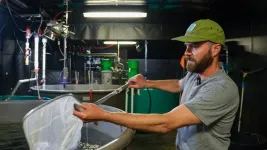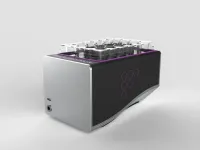(Press-News.org) From seat cushions to mattresses to insulation, foam is everywhere — even if we don’t always see it.
Now, researchers at The University of Texas at Dallas have fused chemistry with technology to create a 3D-printed foam that is more durable and more recyclable than the polymer foam found in many everyday products.
The research, which appears in the March 1 print edition of RSC Applied Polymers, a journal of the Royal Society of Chemistry, focused on creating a sturdy but lightweight foam that could be 3D-printed, a method that is still largely unexplored in commercial manufacturing, said the study’s co-lead author, UT Dallas doctoral student Rebecca Johnson BS’20.
“This is probably the longest project I’ve ever done,” said Johnson, who plans to complete her PhD in chemistry in May. “From start to finish, it was a little over two years. A lot of it was trying to get the polymer formulation correct to be compatible with the 3D printer.”
Although making new materials that are compatible with 3D technology is challenging, Johnson said, the 3D-printing process allowed the researchers to create complex shapes that could be customized in manufacturing applications. To demonstrate the proof-of-concept, they produced foam in the shape of a balloon dog. They also described their work in a YouTube video.
“The goal of the project was to address some limitations in 3D printing in terms of making polymer foam,” said Dr. Ron Smaldone, associate professor of chemistry and biochemistry in the School of Natural Sciences and Mathematics and the corresponding author of the study. “One of the main uses, or interests, for 3D-printable foams is insulation and shock absorption.”
With more research and experimentation, Smaldone said, this type of foam and process could be used for high-impact absorption items such as motorcycle or football helmets, car bumpers or armor. He also noted that 3D printing enables the creation of more complex structures, such as fine lattices, which can increase the physical flexibility of the material and provide more versatility for applications.
The researchers also examined how to make a material that could be 3D-printed into a consistent final product without a lot of defects. Most commercial foam is thermoset, meaning it undergoes a chemical reaction during molding that permanently locks its structure in place, preventing it from being reshaped, melted or dissolved. As a result, most polymer foam cannot be recycled and ultimately ends up in landfills, Smaldone said.
The UT Dallas researchers developed their durable foam using special reversible bonds, called dynamic covalent chemistry. Although the foam cannot be completely melted and reshaped like plastic, these bonds allow the material to repair itself when damaged, making it more versatile and longer lasting.
“We’re certainly not the only ones trying to do this,” Smaldone said. “The novelty is using dynamic chemistry to print really great foam material. The next question to address will be, how do we tune the properties and use this new kind of knowledge to fit a variety of different needs?”
Johnson and the study’s other co-lead author, chemistry doctoral student Ariel Tolfree BS’23, developed their ideas after studying similar research in the field. Tolfree, who credits Johnson as her mentor, plans to expand on the research by examining how to make the foam more recyclable and exploring the foam’s sustainability potential.
Tolfree said creating a foam balloon dog as one of the group’s test objects was a natural choice.
“It’s a simple shape but perfectly represents our foams,” Tolfree said. “A balloon seems ordinary until it’s twisted into something new, almost defying expectations. Our foams are the same — unassuming at first, but once expanded and transformed, they become something remarkable.”
Additional UT Dallas co-authors of the study are mechanical engineering doctoral student Gustavo Felicio Perruci; chemistry doctoral students Lyndsay Ayers BS’24 and Niyati Arora; chemistry senior Emma Liu; Vijayalakshmi Ganesh BS’23; and Dr. Hongbing Lu, professor of mechanical engineering and the Louis Beecherl Jr. Chair in the Erik Jonsson School of Engineering and Computer Science.
The research was funded by The Welch Foundation, the National Science Foundation (2323729, 2219347) and the Department of Energy (DE-NA0003962, DE-EE0011016, DE-EE0010200).
END
Researchers’ 3D-printing formula may transform future of foam
2025-04-03
ELSE PRESS RELEASES FROM THIS DATE:
Nurture more important than nature for robotic hand
2025-04-03
How does a robotic arm or a prosthetic hand learn a complex task like grasping and rotating a ball? The challenge for the human, prosthetic or robotic hand has always been to correctly learn to control the fingers to exert forces on an object. The sensitive skin and nerve endings that cover our hands have been attributed with helping us learn and adapt our manipulation, so roboticists have insisted on incorporating sensors on robotic hands. But–given that you can still learn to handle objects with gloves on– there must be something else at play.
This mystery is what inspired researchers in the ValeroLab in the Viterbi School of Engineering ...
Drug-delivering aptamers target leukemia stem cells for one-two knockout punch
2025-04-03
CHAMPAIGN, Ill. — Drug-carrying DNA aptamers can deliver a one-two punch to leukemia by precisely targeting the elusive cancer stem cells that seed cancer relapses, researchers at the University of Illinois Urbana-Champaign report.
The aptamers — short single-strand snippets of DNA that can target molecules like larger antibodies do — not only deliver cancer-fighting drugs, but also are themselves toxic to the cancer stem cells, the researchers said.
Led by Xing Wang, a U. of I. professor of bioengineering and of chemistry, the researchers documented their findings in the journal Advanced Functional Materials.
“This ...
New study finds that over 95% of sponsored influencer posts on Twitter were not disclosed
2025-04-03
New INFORMS journal Marketing Science Article Key Takeaways:
Over 95% of sponsored influencer posts on Twitter were not disclosed.
Influencer sponsorship arrangements with younger brands are less likely to be disclosed.
A large number of consumers can’t detect the sponsorship arrangement without disclosure.
The consumer-protection regulatory environment around undisclosed sponsorships has lagged behind.
BALTIMORE, MD, April 3, 2025 – New research in the peer-reviewed journal Marketing Science has found that 95% of influencer posts on Twitter (now X), which are sponsored, are not disclosed.
The ...
New sea grant report helps great lakes fish farmers navigate aquaculture regulations
2025-04-03
DULUTH, Minn.–Fish farmers across the Great Lakes states can face a confusing web of permits, policies and regulations that can hinder the growth of their operations. A new Sea Grant publication, Aquaculture Regulations in the Great Lakes, offers much-needed clarity.
The report breaks down complex legal frameworks and provides practical insights to help aquaculture producers understand and navigate state and regional requirements with greater confidence. It was developed by the National Sea Grant Law Center (NSGLC) ...
Strain “trick” improves perovskite solar cells’ efficiency
2025-04-03
Solar energy is one of the most promising solutions for reducing our dependence on fossil fuels. But making solar panels more efficient is a constant challenge. Perovskite solar cells (PSCs) have been a game-changer, offering rapid improvements in efficiency and potential for low-cost manufacturing. However, they still suffer from energy losses and operational stability issues.
The challenge with wide-bandgap perovskites
Perovskite solar cells, particularly those used in tandem configurations, rely on wide-bandgap (WBG) materials—semiconductors that absorb higher-energy ("bluer") ...
How GPS helps older drivers stay on the roads
2025-04-03
How GPS helps older drivers stay on the roads
Peer reviewed – observational study - humans
Sat Nav systems help keep older drivers on the roads for longer, according to new research from the University of East Anglia.
A new study published today reveals that over 65s with a poorer sense of direction rely more on help from GPS navigation systems such as Sat Nav or smartphone maps.
Those using GPS tended to drive more frequently - suggesting that the technology helps older people maintain driving independence.
Senior author Prof Michael Hornberger, from UEA’s Norwich Medical School, said: “Driving is usually the preferred mode of transport among ...
Estrogen and progesterone stimulate the body to make opioids
2025-04-03
Scientists have discovered a new mechanism that acts via an immune cell and points toward a different way of treating chronic pain.
Female hormones can suppress pain by making immune cells near the spinal cord produce opioids, a new study from researchers at UC San Francisco has found. This stops pain signals before they get to the brain.
The discovery could help with developing new treatments for chronic pain. It may also explain why some painkillers work better for women than men and why postmenopausal ...
Dancing with the cells – how acoustically levitating a diamond led to a breakthrough in biotech automation
2025-04-03
Engineers at a University of Bristol spin-out company have created a new technology that can move cells without touching them, enabling critical tasks that currently require large pieces of lab equipment to be carried out on a benchtop device.
The invention could accelerate the discovery of new medicines and unlock personalised medicine screening in clinics.
The groundbreaking concept was unveiled for the first time today in an article in Science published by Dr Luke Cox, where he describes his journey from University of Bristol ...
Machine learning helps construct an evolutionary timeline of bacteria
2025-04-03
University of Queensland scientists have helped to construct a detailed timeline for bacterial evolution, suggesting some bacteria used oxygen long before evolving the ability to produce it through photosynthesis.
The multinational collaboration – led by researchers from the Okinawa Institute of Science and Technology, the University of Bristol, Queensland University of Technology and UQ – focused on how microorganisms responded to the Great Oxygenation Event (GOE) about 2.33 billion years ago, which changed ...
Cellular regulator of mRNA vaccine revealed... offering new therapeutic options
2025-04-03
A team of researchers led by Dr. KIM V. Narry, director of the Center for RNA Research at the Institute for Basic Science (IBS), has uncovered a key cellular mechanism that affects the function of mRNA vaccines and therapeutics. Their study, recently published in Science, provides the first comprehensive understanding of how mRNA vaccines are delivered, processed, and degraded within cells—a breakthrough that could pave the way for more effective vaccines and RNA-based treatments.
Messenger RNA (mRNA) is the genetic blueprint that tells cells how to produce proteins. It plays a vital role in mRNA vaccines, such as those used for COVID-19, and is also a promising ...




